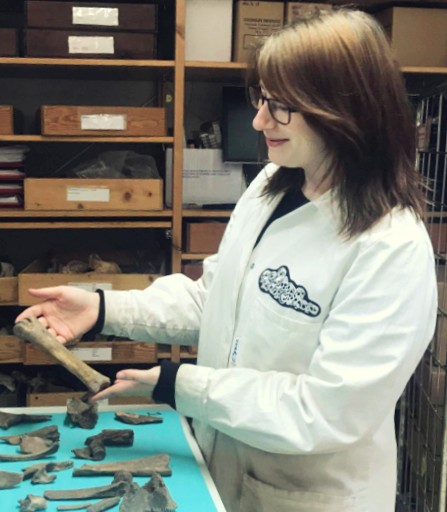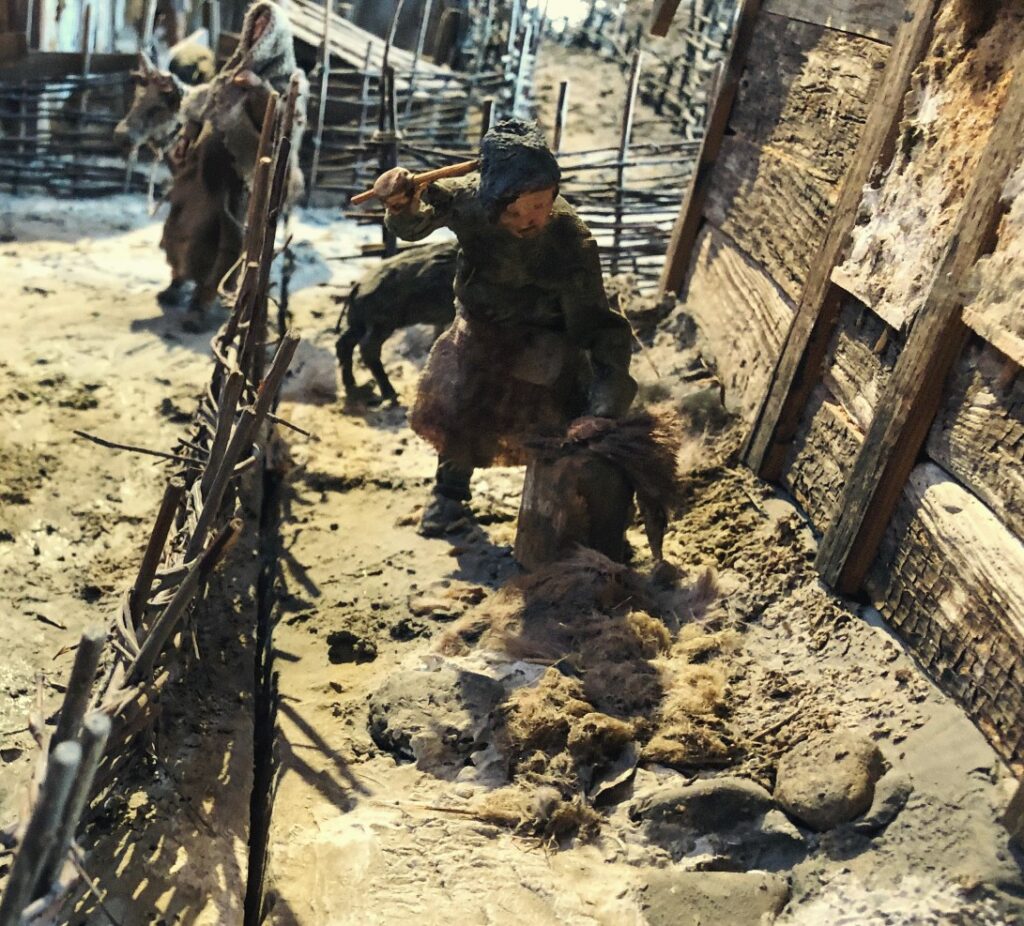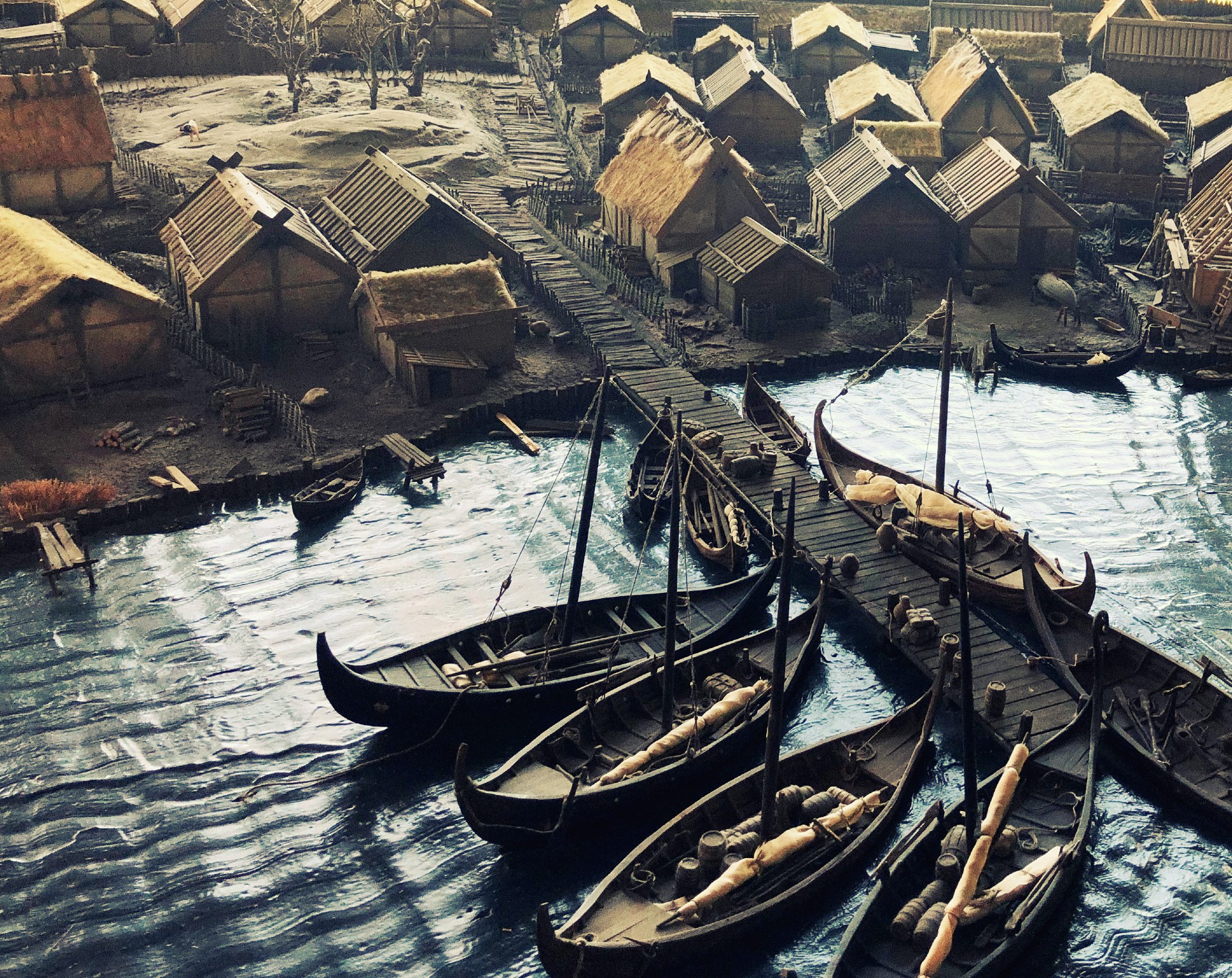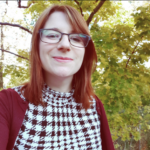An osteological and isotopic analysis of the animal bone material from the Birka harbour
Birka is one of the most famous Viking Age towns in Scandinavia, often compared to similar towns such as Kaupang and Ribe. Birka flourished as a town during the Viking Age between 750 to 975 A.D and was a trading port with a wide array of connections all over the world. It was a trading hub in Europe and archaeological material showcases evidence of trade in objects such as coins, beads, antlers and furs. Nobody knows exactly when Birka was founded but have had the propertied as a town from 750 A.D and was abandoned around 975 for unknown reasons. Over the years, Birka as a Viking Age town, has been researched extensively and even become a wide media phenomenon, most recently through the establishing of a female Viking warrior. Even though Birka have been partly excavated and a lot of research have been carried out about the site, there is still much more to explore.
One thing that can help us with this task is bones.
How can bones aid us in this task of understanding Birka as a town, and the lives of the people who used to inhabit it centuries ago?
Birka has been excavated for more than one century, with the first one taking place in the late 19th century by Hjalmar Stolpe. Birka is still being excavated in modern times, and one of the more recent excavations made by Stockholms University in 2015-16 aimed at exploring a possible harbour after the discovery of a jetty post nearby. This excavation yielded a vast amount of animal bone. The surrounding area was covered in water back in the Viking Age, and it is likely that the bones had been discarded as waste into the water. This was not an uncommon method of dumping trash back then, since it will smell significantly less inside a body of water. This method of discarding rubbish has protected the material from common wear and has left the bone material in excellent condition.
The bone material that was found in the harbor area inspired an ongoing collaboration between two archaeologists with different scientific specialization. Archaeometry is the use of scientific techniques within archaeology, and it is two methods from this field that has been used to examine the harbor bones. The excellent preservation has resulted in an increase in both the quantity and the quality of the bone material, which allows for more extensive and varied research to be applied to this material. This research can answer questions about Birka relating to urbanism, subsidence and city development regarding Birka as a town.
Isotopic analysis: Tracing diets, tracing animals

So how can we actually use animal bones to answer questions relating to the human past? The two most common archaeometric methods applied on bone material are isotopic analysis and osteological science. The first one, isotopic analysis, allow archaeologists to get a better understanding of consumption in regard to the dead individual: what they ate growing up, what they ate in their adulthood, and where this food originated from. Isotope analysis in the field of archaeology can be used for dating, or tracing diets. There are two main isotope groups: one is called stable isotopes, and are used for tracing diet, and the other one is called unstable isotopes, and this can be used to accurately determine the age of archaeological material. Isotopes are incorporated in bone tissue throughout an organism’s life, and the intake stops when the organism dies. Therefore, we usually sample bone or teeth to do isotopic analysis on. Stable isotopes do not decay over time like unstable isotopes, and they exist in nature in different amounts. This is a brief summary of how isotopic analysis is used in the field of archaeology.
Isotopic analysis is an excellent method to better understand questions relating to city development and urbanism, as we do not actually know a lot about the animals that were consumed at Birka.
Osteological analysis: Bones, bones, bones

Osteological analysis, which is the second method, is focused on identifying the bones: what animal they were once a part of, which bone it is, and how the animal once was treated. For instance, through osteological methods we can see if there are visible butchery marks, whether the bone has been broken off in any way or is there any visible human handling of the bone. This type of analysis is perfect to better understand human subsidence, animal upkeep and butchery practices.
Osteology is the field of study which relates to the skeleton in anatomical terms, such as the structure of bones, and zooarchaeology is the subcategory of archaeology that deals with animal bones. Through osteological methods, bone-material can be identified, and skeletal elements analyzed, to better understand a site and its inhabitants. This is an important part of working with bone material, as the material needs to be quantified to be understood.
What can the methods do to help us understand the bones?
It is the diet aspect that is of interest here. The animal bones from Birka can be sampled, and isotope analysis can then tell us about the diet of the animals. One reason for examining the diet of the animals is to investigate whether the animals were raised close to Birka, or further away. This is interesting for a couple of reason. First and foremost; if the animal’s diet is consequent of being reared further away from Birka, this means that the network Birka had was quite far reaching. In this regard, the question of urbanisation becomes relevant in the fact that it can tell us something about food resources to the town of Birka, and other towns like it. The aim with this multi-isotopic analysis of the animal bones from Birka is to get a better understanding of how and how far the food provisioning network stretched.
So then, what can actually be understood by applying osteological / zooarchaeological methods? We know that people lived at Birka, and we know from the bone material that domesticated animals was a big part of the diet, but there are a lot of things that we do not know. For one thing, we do not know what species of animals the primary source of food was. We also do not know how many wild animals were consumed, such as bird and fish, in ratio with the domesticated animals. Diet plays an important part of people’s lives, both today and in the past, and understanding the sustenance practices of a historical place can also be of help in answering the bigger questions as we have mentioned here.
Another interesting question which can be answered by applying osteological methods, is where the domesticated animals were kept. We know from the osteological materials that cattle, pig, sheep and goats were consumed at the site, but we do not know where they came from. It would normally be assumed that the animals were kept on-site, meaning at Birka. But the island of Björkö, where Birka stood, is relatively small. It may have housed as many as 1000 people at one point, a conclusion we base on the many graves excavated here, which is a lot of mouths to feed. Fitting enough domesticated animals to feed this many people would be difficult, and it is therefore likely that the animals were kept elsewhere. As mentioned earlier, isotopic analysis can reveal more information on what an animal ate prior to dying, which could help answer the question of whether the animals were local or imported from afar. This can be used alongside the osteological findings, which may also offer clues on where the animals were kept.

The harbor excavation has been a fairly unique chance to conduct this type of analysis on Birka, specifically due to the incredible preservation of the bones. Archaeological bones, both in Scandinavia and in other places, tends to be in poor condition. Unfavorable soil conditions can break down material over time, and agricultural activity such as ploughing also causes terrible wear. However, due to the material being preserved under water, the bones were in many parts more protected from this. An unusual amount of intact bones has been recovered from this excavation, such as long bones from cows. Because of this, it is possible to calculate the average size of cows from this time. This is especially interesting since cows have varied in size over time, as they have gone through different phases of domestication. The cows from the Viking Age were significantly smaller than modern variants, some even the size of a large dog.

Let us take a look at an exciting and very well preserved find from Birka. A skull of a cow was found in the harbor. The skull was almost entirely intact, other than a missing horn which was located next to it. Skull fragments have been found from the same excavation but not in the same intact state. What’s especially fascinating with this skull is that the top of it, the frontal bone, has an indentation. This was likely caused by blunt force trauma: slaughter gone wrong? It would most likely not had killed the cow but would most definitely have hurt it. The indentation lines are visible on the picture above, showing what the skull looked like when originally excavated.
Concluding thoughts
So, what can animal bones actually tell us about the lives lived in Birka and how they kept their animals? Investigating animal bones through scientific methods will allow us to answer broader questions pertaining to the town. Not just what animals they ate, but where these animals came from, at which season they ate what animals, and trading connections involved in their sustenance practices. To investigate this, it is almost like understanding which grocery store that they, the Viking Age inhabitants of Birka, preferred to shop at. Archaeometric methods can be applied in a variety of ways with archaeological material. By doing something slightly less common with the Birka material, and something seemingly less exciting, we are getting a better understanding of the big and very interesting questions pertaining to the town. Prior emphasis has been put on the enormous number of graves at Birka, as well as the trading connections and the archaeological material in itself. Let us look for something different. Let us look at the rubbish, because it is often by looking at the trash that you can get a better understanding of a person or a city. One man’s trash is another man’s treasure.
Photos: Cover: Birka miniature, Lovisa Sénby Posse, 2020. Copyright 2020 Scandinavian Archaeology.
Isotope analysis: Molly Wadstål and Nicoline Schjerven, 2020. Copyright 2020 Scandinavian Archaeology.
Osteological analysis: Molly Wadstål and Nicoline Schjerven, 2020. Copyright 2020 Scandinavian Archaeology.
Close up animal at Birka: Lovisa Sénby Posse, 2020. Copyright 2020 Scandinavian Archaeology.
Cow skull: Antje Wendt, 2016. Stockholm Universitet.
Text: Molly Wadstål and Nicoline Schjerven, 2020. Copyright 2020 Scandinavian Archaeology
Further reading:
Excavation reports, Birka
Sven Kalmring & Lena Holmquist. 2020. Reviving Birka’s Black Earth Harbour. The Results of the 2015/16 Field Campaign. In: A. Pedersen & S.M. Sindbæk (eds.), Viking Encounters. Proceedings of the Eighteenth Viking Congress (Aarhus 2020) 249-256.
Sven Kalmring & Lena Holmquist. 2018. “The Gleaming Mane of the Serpent”. The Birka Dragonhead from Black Earth Harbour. Antiquity 92, 2018, 742-757.
Birka
Ambrosiani, Björn, and Phyllis Anderson Ambrosiani. 2005. Birka and Scandinavia’s Trade with the East.
Ambrosiani, Björn, and Bo G. Erikson. 1991. Birka: Vikingastaden, Volume 1.
Isotopic analysis
Brown, Terence A, and Keri Brown. 2011. Biomolecular archaeology: an introduction.
Hamilton, W. Derek, Kerry L. Sayle, Marcus O. E. Boyd, Colin C. Haselgrove, and Gordon T. Cook. 2019. ‘Celtic cowboys’ reborn: Application of multi-isotopic analysis (δ13C, δ15N, and δ34S) to examine mobility and movement of animals within an Iron Age British society.
Price, T Douglas, Caroline Arcini, Ingrid Gustin, Leena Drenzel, and Sven Kalmring. 2018. Isotopes and human burials at Viking Age Birka and the Mälaren region, east central Sweden.
Sayle, Kerry L, Christopher R Brodie, Gordon T Cook, and W Derek. 2019. Sequential measurement of δ15N, δ13C and δ34S values in archaeological bone collagen at the Scottish Universities Environmental Research Centre (SUERC): a new analytical frontier.
Sayle, Kerry L, Gordon T Cook, Philippa L Ascough, Helen R Hastie, Árni Einarsson, Thomas H McGovern, Megan T Hicks, Ágústa Edwald, and Adolf Friðriksson. 2013. Application of 34S analysis for elucidating terrestrial, marine and freshwater ecosystems: evidence of animal movement/husbandry practices in an early Viking community around Lake Mývatn, Iceland.
Osteological analysis
Ericson, Per GP, Elisabeth Iregren, and Maria Vretemark. 1988. Animal exploitation at Birka-a preliminary report. Fornvännen.
Wigh, Bengt. 2001. Animal husbandry in the Viking Age town Birka and its hinterland.
Wright, David K. 2017. Paleoenvironmental Science: Methods.




